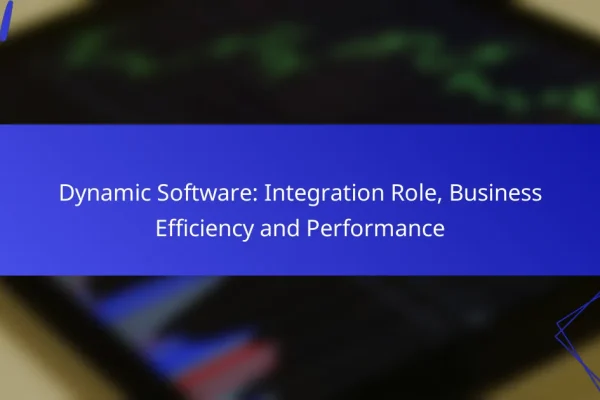What are the best dynamic software integration solutions for e-commerce?
The best dynamic software integration solutions for e-commerce streamline processes, enhance data flow, and improve customer experiences. Key options include Zapier, MuleSoft, Integromat, Shopify API, and Salesforce Integration Cloud, each offering unique features tailored to different business needs.
Zapier for automation
Zapier is a user-friendly platform that connects various web applications to automate workflows without coding. It allows e-commerce businesses to create “Zaps,” which are automated workflows that trigger actions in one app based on events in another.
For instance, a Zap can automatically add new customers from a Shopify store to a Mailchimp email list. This integration saves time and reduces manual data entry, making it ideal for small to medium-sized businesses looking to enhance efficiency.
MuleSoft for enterprise integration
MuleSoft provides a robust integration platform designed for large enterprises needing to connect complex systems and data sources. It offers tools to build APIs and integrate applications, allowing for seamless data exchange across various platforms.
With MuleSoft, e-commerce companies can unify customer data from multiple sources, improving insights and decision-making. However, it may require a higher investment and technical expertise compared to simpler solutions like Zapier.
Integromat for workflow automation
Integromat, now known as Make, is a powerful automation tool that enables users to create intricate workflows between apps. It supports a wide range of integrations, making it suitable for businesses that need to automate complex processes.
For example, an e-commerce business can set up a scenario where a new order triggers updates in inventory management, shipping notifications, and customer communication. This flexibility allows for tailored solutions that can adapt to specific operational needs.
Shopify API for e-commerce
The Shopify API provides developers with the tools to build custom integrations and applications tailored to e-commerce needs. It allows for direct access to store data, enabling businesses to create unique shopping experiences and manage their operations effectively.
Using the Shopify API, businesses can automate inventory updates, process orders, and integrate third-party services. This capability is particularly beneficial for larger e-commerce platforms that require extensive customization and scalability.
Salesforce Integration Cloud
Salesforce Integration Cloud is designed to connect Salesforce applications with other systems, providing a comprehensive view of customer interactions. This integration is essential for e-commerce companies that rely on customer relationship management (CRM) to drive sales and marketing efforts.
By leveraging Salesforce Integration Cloud, businesses can synchronize customer data across platforms, ensuring a cohesive experience. However, it may require a significant investment and ongoing management to maintain effective integrations.
How do dynamic software integrations improve e-commerce operations?
Dynamic software integrations enhance e-commerce operations by enabling seamless communication between various systems, which leads to improved efficiency and better decision-making. These integrations allow for real-time data exchange, ensuring that businesses can respond quickly to changes in demand and customer preferences.
Streamlined data flow
Streamlined data flow is crucial for e-commerce success, as it reduces the time spent on manual data entry and minimizes errors. By integrating systems such as inventory management, customer relationship management (CRM), and payment processing, businesses can automate data transfers and ensure that all platforms are synchronized.
For example, when a customer places an order, the integration can automatically update inventory levels and notify the shipping department without any manual intervention. This leads to faster order fulfillment and improved operational efficiency.
Enhanced customer experience
Dynamic software integrations significantly enhance the customer experience by providing personalized interactions and faster service. When customer data is shared across platforms, businesses can offer tailored recommendations and promotions based on previous purchases and browsing behavior.
Additionally, integrated systems can facilitate quicker response times to customer inquiries, whether through chatbots or customer service representatives. This responsiveness fosters customer loyalty and increases the likelihood of repeat purchases.
Real-time inventory management
Real-time inventory management is essential for e-commerce businesses to avoid stockouts and overstock situations. Dynamic integrations allow for continuous updates on inventory levels across all sales channels, ensuring that businesses have accurate information at their fingertips.
For instance, if a product sells out on one platform, the integration can automatically update other platforms to prevent further sales until restocking occurs. This proactive approach helps maintain customer satisfaction and optimizes inventory turnover.
What are the key features of dynamic software integration platforms?
Dynamic software integration platforms offer essential features that enhance connectivity and data management across various applications. These platforms enable seamless communication between systems, allowing for real-time data exchange and improved operational efficiency.
API connectivity
API connectivity is a fundamental feature of dynamic software integration platforms, allowing different software applications to communicate with each other. By utilizing APIs, organizations can connect their existing systems with third-party services, enabling data flow and functionality integration.
When selecting a platform, consider the variety of APIs supported, including REST, SOAP, and GraphQL. A robust API ecosystem facilitates faster integration and reduces the need for extensive custom coding.
Data transformation capabilities
Data transformation capabilities are crucial for ensuring that data from different sources can be accurately interpreted and utilized. These features allow users to convert, map, and enrich data formats to meet specific business needs.
Look for platforms that offer built-in transformation tools, such as ETL (Extract, Transform, Load) processes, to streamline data handling. This can significantly reduce the time spent on manual data preparation, leading to quicker insights and decision-making.
User-friendly interfaces
User-friendly interfaces are essential for enabling non-technical users to navigate and utilize integration platforms effectively. A well-designed interface simplifies the integration process, making it accessible to a broader range of users within an organization.
Choose platforms that provide intuitive dashboards, drag-and-drop functionality, and clear documentation. These features can enhance user adoption and minimize training time, allowing teams to focus on leveraging integrations rather than struggling with complex tools.
What are the prerequisites for implementing dynamic software integration?
To successfully implement dynamic software integration, organizations must establish clear business objectives and ensure compatibility with existing software systems. These prerequisites help streamline the integration process and maximize the benefits of new solutions.
Clear business objectives
Defining clear business objectives is crucial for effective dynamic software integration. Organizations should identify specific goals such as improving operational efficiency, enhancing customer experience, or reducing costs. These objectives guide the integration strategy and help measure success.
When setting these objectives, consider using the SMART criteria: Specific, Measurable, Achievable, Relevant, and Time-bound. For example, aiming to reduce processing time by 20% within six months provides a clear target to work towards.
Existing software compatibility
Assessing existing software compatibility is essential before initiating dynamic integration. Organizations need to evaluate whether current systems can communicate effectively with new software solutions. This includes checking for compatible APIs, data formats, and protocols.
Conducting a compatibility audit can help identify potential issues early on. For instance, if a legacy system uses outdated data formats, it may require additional resources to bridge the gap with modern applications. Prioritize integrations that offer seamless interoperability to minimize disruptions and maximize efficiency.
How to choose the right dynamic software integration tool?
Choosing the right dynamic software integration tool involves understanding your specific integration needs and evaluating the options available in the market. Consider factors such as scalability, user support, and documentation to ensure the tool aligns with your business objectives.
Assess integration needs
Start by identifying the systems and applications that require integration. Determine the data flow between these systems and the frequency of updates needed. For instance, if you need real-time data synchronization between a CRM and an ERP, ensure the tool supports such capabilities.
Also, consider the types of data you will be integrating, such as structured or unstructured data. This will help you select a tool that can handle the specific formats and protocols relevant to your business processes.
Evaluate scalability options
Scalability is crucial for accommodating future growth. Assess whether the integration tool can handle increased data volume and additional applications without significant performance degradation. Look for tools that offer cloud-based solutions, as they often provide better scalability compared to on-premises options.
Check if the tool allows for easy addition of new integrations or modifications to existing ones. This flexibility can save time and resources as your business evolves.
Consider user support and documentation
Robust user support and comprehensive documentation are essential for effective implementation and troubleshooting. Review the support options available, such as live chat, email, or phone support, and consider the responsiveness of the provider.
Additionally, evaluate the quality of the documentation, including user guides, tutorials, and FAQs. Well-documented tools can significantly reduce the learning curve and help your team resolve issues more efficiently.
What are the costs associated with dynamic software integration?
The costs associated with dynamic software integration can vary widely based on several factors, including the platforms used, the complexity of the integration, and the resources required for implementation. Understanding these costs is crucial for budgeting and planning effective integration strategies.
Subscription fees for platforms
Subscription fees for integration platforms can range from low monthly rates to high annual costs, depending on the features and scalability required. Basic plans may start around $50 per month, while more comprehensive solutions can exceed $1,000 monthly. It’s essential to evaluate the pricing tiers and features to ensure alignment with your integration needs.
Many platforms offer tiered pricing based on usage, so consider your expected transaction volume when selecting a plan. Additionally, some providers may charge extra for advanced features or additional users, which can significantly impact overall costs.
Implementation costs
Implementation costs can include expenses for consulting services, custom development, and training. Depending on the complexity of the integration, these costs can range from a few thousand to tens of thousands of dollars. Engaging experienced consultants can streamline the process but may add to the initial investment.
To minimize implementation costs, consider leveraging existing resources or tools that facilitate integration. Additionally, ensure that your team receives adequate training to reduce reliance on external support in the long run. Planning for ongoing maintenance and updates is also vital, as these can incur further expenses over time.












